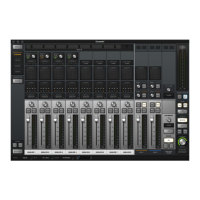Apollo Thunderbolt Software Manual Latency & Apollo 183
Latency Basics
Latency (delay) is an inherent factor in digital audio systems because of A/D-D/A
conversion, I/O buffering in the DAW, plug-in signal processing, and other aspects.
Although there are ways to mitigate latency (such as delay compensation and/or low-
latency monitoring), it always exists to some degree when working with systems that
combine analog and digital audio. These concepts are explained in greater detail below.
Audio Interface Latency
Every audio interface that performs A/D and/or D/A conversion induces latency as a result
of the conversion process. This inherent A/D–D/A latency is essentially undetectable.
A/D–D/A latency usually depends on the sample rate, with higher sample rates inducing
less latency (higher rates = less time required for conversion).
An audio interface’s “analog I/O round-trip latency” specification refers to how long it
takes for an analog signal at an interface input to reappear at the same interface’s analog
output after both A/D and D/A conversion. Apollo’s audio interface analog I/O round-trip
latency is 1.1 milliseconds at a sample rate of 96 kHz.
Console Mixer Latency
Apollo’s Console DSP mixer is used for low-latency monitoring (cue mixing) of Apollo’s
analog and digital inputs. Using Console to monitor Apollo’s inputs may or may not add
to the inherent analog I/O round-trip latency, depending on how it is configured:
Console without UAD plug-ins – When Console is used without UAD plug-ins, monitoring
Apollo’s inputs via Console does not add any latency. In this configuration, Apollo’s
analog I/O round-trip latency is still 1.1 milliseconds at 96 kHz.
Console with Realtime UAD Processing – When Console is used for Realtime UAD
Processing with UAD Powered Plug-Ins that are not upsampled, monitoring Apollo’s
inputs via Console does not add any latency.
In this configuration, Apollo’s analog I/O round-trip latency is still 1.1 milliseconds at 96
kHz, even if up to four UAD (non-upsampled) plug-ins are serially “stacked” (chained) on
a single Apollo analog and/or digital input.
Multiple Apollo inputs can have up to four UAD (non-upsampled) plug-ins each (up to
the limit of available DSP resources); this configuration also does not add any latency.
Note: Upsampled UAD plug-ins add latency when used in Console or a DAW. See
Upsampled UAD plug-ins below for details.
Console Auxiliary Buses – The outputs of the auxiliary buses in Console have 32 samples
of additional latency. This is necessary to maintain the lowest possible input latency.

